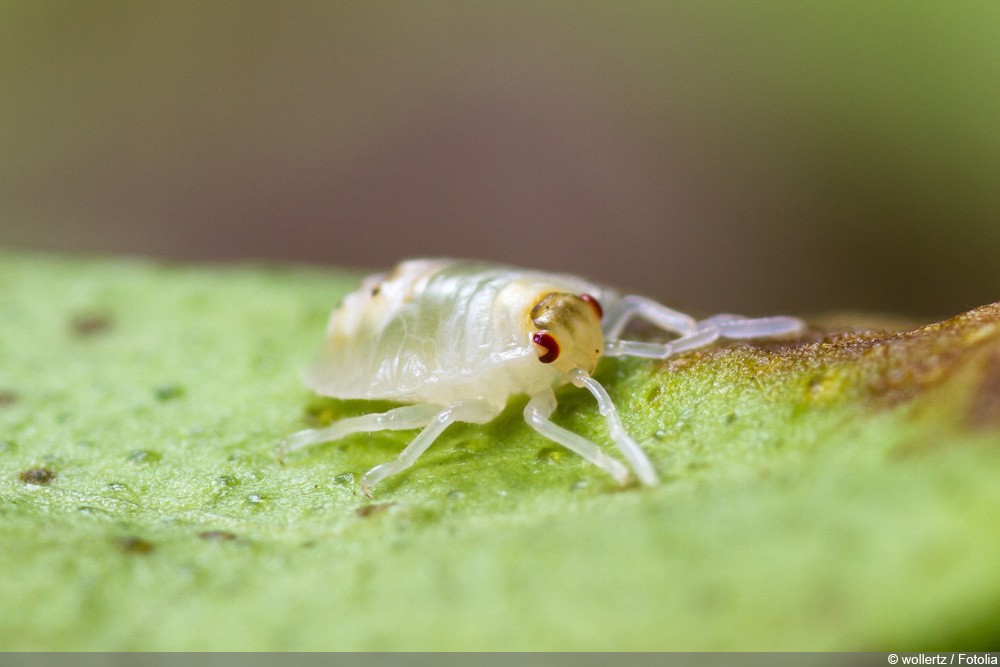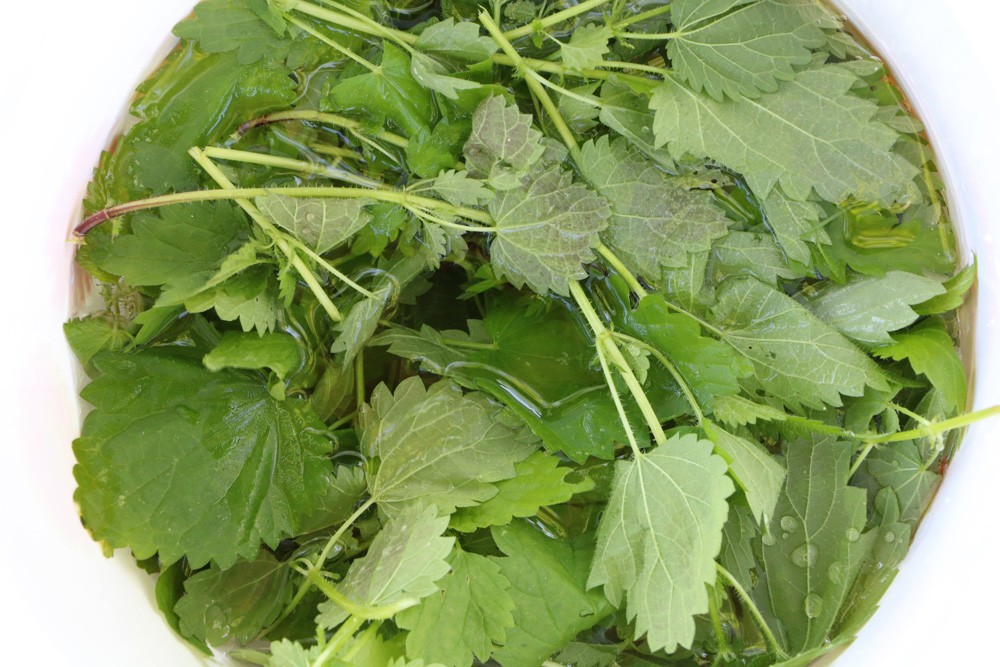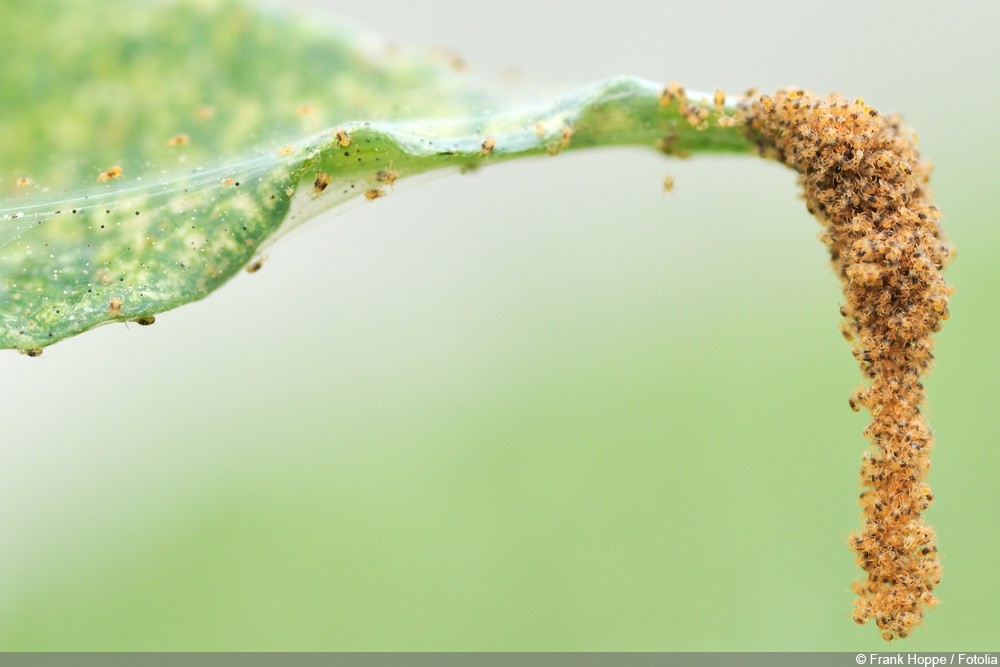Tomatoes and spider mites have the same preferences in terms of climate: Both like warm and dry weather. So it’s no wonder that the tiny creatures can become a real nuisance, especially since they multiply rapidly and can pose a threat not only to the tomato crop, but also to neighboring plantations. Hardly any plant is safe from the creepy-crawlies. With these five non-toxic home remedies, you are guaranteed to keep the leaf suckers at bay.
Contents
Damage
Spider mites are tiny animals: between 0.25 and 0.8 millimeters long, the pests are therefore invisible to the naked eye. This is also the reason why an infestation is often only discovered very late – namely when the leaf suckers have already caused greater damage. To prevent this from happening to you, you should regularly check your tomato plants for pests and diseases. It is not only important to keep an eye on spider mites, but also other unwanted infestations. The sooner you spot any problems, the easier it will be to contain them – and the less damage there will be.
You can recognize a spider mite infestation by these characteristics:
- fine webs on leaf edges and leaf axils
- often only visible after spraying with a fine water mist
- Suction damage on leaves
- typical are bright, tiny spots on the leaves
- Leaves appear speckled
- spots often have a silvery sheen
- later silvery or bronze-colored leaf spots
- leaves curl up and dry out
- shedding of yellowed leaves
- Growth disturbances with heavy infestation
- plants wither, hardly develop flowers and fruits

Furthermore, spider mites do not always appear alone, but often transmit harmful and difficult to combat viruses. Thus, the causes for the loss of carefully nurtured and cared for tomato plants are not only the leaf suckers, but also secondary infections. Ergo, in the case of a strong and persistent infestation, you need to fight not only the pests themselves, but also secondary diseases at the same time.
By the way, tomatoes are particularly at risk if they are cultivated on balconies or in greenhouses. Nevertheless, invasion is not uncommon even in outdoor crops, provided the site and weather conditions are right.
Prevention
To prevent your tomato plants from suffering from a spider mite invasion in the first place, you can take preventative action. By doing so, you won’t always be able to prevent an infestation, but you will make it less likely. The following measures will help make life difficult for the little animals:
- Airing tomatoes in the greenhouse several times a day.
- installation of suitable devices for this purpose, e.g. liftable skylights
- Avoid accumulation of air / dry heat in the greenhouse.
- Keep soil / substrate moist
- mulch the soil to retain moisture longer
- Fertilize tomatoes in a balanced and potassium-rich way
- Avoid overfertilization, especially with nitrogen.
In principle, effective prevention against spider mites is difficult, however, because tomato plants prefer hot and sunny locations and should also be cultivated as dry as possible. Damp leaves are a common cause of the dreaded late blight, which quickly ruins plants and fruit alike. Therefore, when caring for tomatoes, make sure that the leaves do not become damp – even through increased humidity! However, a slightly moist planting soil, a balanced as well as an airy (not drafty!) location will help prevent a spider mite infestation.
Prefer non-toxic home remedies
However, sometimes the little animals can not be stopped, despite the best efforts. In this case, prefer non-toxic home remedies, with which the plague can usually be contained quite well. In contrast to chemical insecticides from the specialized trade, these have many a tangible advantage:
- favorably
- often can be made with simple ingredients
- biological and ecological
- non-toxic for humans and the environment
- protection of useful garden inhabitants such as natural predators, but also bees, bumblebees & Co.
- strengthen infested tomato plants and their own immune defenses
- Fruits of treated plants remain edible
- By the way, such homemade home remedies are particularly effective when they not only combat the spider mites themselves, but also the causes of infestation.
The most common causes of spider mite infestation:
- unfavorable location (too hot / too sheltered, such as in front of a bright wall on the south side of the garden).
- too dry soil / too dry substrate
- lack of ventilation in the greenhouse and on the balcony
- unbalanced fertilization (under- or oversupply)
- The above causes stress the plants, which is why they become more susceptible to infestation not only with spider mites, but also with other pests or pathogens. Therefore, ensure a warm and sunny, but airy location and optimal care, where even prepared plant strengtheners may be used with pleasure.
Effectively control spider mites
- The 5 best methods –
By the way, the creepy-crawlies, often called “red spider”, do not belong to the insects, as many mistakenly think, but to the arachnids. They live only a few days, but reproduce incredibly fast in this short time: several hundred eggs can be laid by a single female, which are preferably found on the undersides of tomato leaves. Therefore, if you want to prevent an invasion, you must be quick and take appropriate countermeasures at the slightest sign. However, you don’t have to worry about your tomato crop for now: as long as you treat the plants with non-toxic agents, the fruits will remain edible.
Remove and dispose of plant parts
Removing infested leaves is the most important control measure. Check the undersides and also tops of tomato leaves and shoots with a magnifying glass and carefully pluck off plant parts covered with eggs. However, in no case dispose of them in the compost, but throw them in the household garbage and immediately knot the ends of the garbage bag. If you prevent the offspring from hatching, you limit the arachnid infestation from the outset. This is all the more true the more heavily the tomato plant is already infested.
Use of beneficial insects

The second effective method of control is the release of beneficial predators such as the predatory mite Phytoseiulus persimilis, which prefers to eat the larvae and eggs of spider mites. However, this species does not survive too long without food and quickly dies. Therefore, a second, less sensitive predatory mite species called Amblyseius californicus can provide relief. These little animals detect even hidden spider mite eggs, but also die after successful control due to food. Naturally, pest control with the help of predatory mites and other beneficial insects works best indoors, such as a greenhouse, but can also be done on outdoor tomatoes. Be sure to apply store-bought animals directly to the leaves of infested plants according to the instructions. Other animal pest controllers with great appetites for spider mites include.
- black ball lady beetles (Stethorus punctillum)
- Lacewings (Chrysoperla carnea).
These two species also work well against other sucking pests such as aphids or thrips, and they also get along very well with predatory mites, so there is nothing to stop them from being used at the same time. However, you must not use any chemical insecticides – not even homemade oil-based ones – if you rely on the beneficial insects. Otherwise, you will kill them at the same time.
Prepare plant broths yourself

Spider mites on tomatoes can also be excellently controlled with home-made plant broths. Horsetail (Equisetum arvense), which grows wild in many places, has proven to be particularly effective. It not only kills off the pesky arachnids, but also strengthens the plant’s own immune system. The plant contains abundant silicic acid, which accumulates in the leaves of the tomato plant and deters a variety of pests and pathogens. The downside, however, is that field horsetail broth only acts as a preventative and does not directly kill the arachnids. So water your tomatoes with the preparation every two weeks. This is completely harmless, so the tomato fruits remain edible as well as tasty even with regular treatment.
This is how you make field horsetail decoction:
You will need 150 grams of fresh field horsetail (collect only the green parts!), a large onion as well as a whole garlic bulb. Chop everything nicely and boil the ingredients in a liter of water. Let it simmer for about 15 minutes, then strain it through a fine sieve or cloth and let the broth cool. Stored airtight in a well-sealed jar, the brew will keep for several months.
Non-toxic spray based on rapeseed oil

If the tomato plants are already heavily infested, only a non-toxic spray based on rapeseed oil will help. Mix two tablespoons of rapeseed oil, two squirts of washing-up liquid and a teaspoon of methylated spirits with a liter of water and wipe the infested parts of the plant with it. Allow it to work for a few hours before rinsing thoroughly with clean water. Repeat the procedure several times at intervals of several days. Make sure that the tomato can dry quickly afterwards to prevent fungal infection. By the way, in no case should the treatment be carried out in bright sunshine, otherwise it may cause severe burns.
Neem oil
Neem oil (or neem oil, as it is sometimes called) is also a well-tolerated organic home remedy that can be used to naturally control spider mites and other leaf suckers. However, since the remedy is imported from India, you should treat your tomatoes with neem, if possible, only when nothing else really helps.
It is better not to use this home remedy
In forums you can sometimes read the advice to put a transparent plastic bag over the tomatoes and practically suffocate the spider mites. However, with this home remedy, you not only fight the spider mites, but also severely damage the delicate tomato plants. Due to the increased temperature and humidity, late blight will subsequently occur, which will certainly destroy your harvest.


